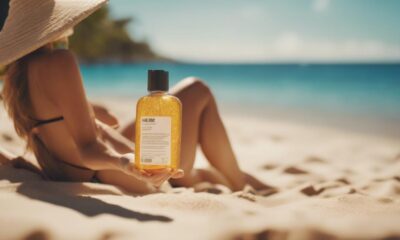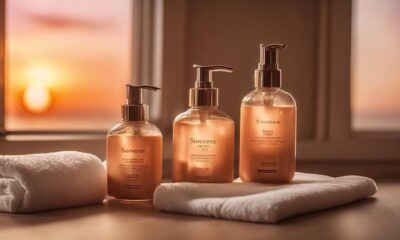Tanned Skin
How to Maintain Your Tan: Expert Tips
Never let your hard-earned tan fade—discover expert tips to keep your glow vibrant and long-lasting!

To maintain your tan, focus on hydration and gentle exfoliation. Keep your skin moisturized with a quality water-based lotion twice a day. Exfoliate weekly to remove dead skin cells without stripping your tan. Apply a self-tanner every 3 to 5 days for an extended glow. Don't forget sunscreen with at least SPF 30 to protect against UV damage and maintain vibrancy. Stay hydrated by drinking plenty of water and eating foods like cucumbers and watermelon. For more ways to enhance and prolong your tan, you'll want to explore a few additional expert tips.
Key Takeaways
- Exfoliate gently 24 hours before applying self-tanner to create a smooth surface for even application.
- Apply a daily moisturizer, preferably water-based, to keep skin hydrated and prolong tan vibrancy.
- Reapply sunscreen with at least SPF 30 daily to protect your tan from UV damage and maintain skin health.
- Use self-tanner maintenance products every 3 to 5 days for consistent color and to avoid patchiness.
Duration of Your Tan
Your tan typically lasts about 7 to 10 days before it starts to fade, whether it's from self-tanner or natural sun exposure. The duration of your tan can vary based on your skin type; for instance, darker skin tones tend to retain their tan longer than lighter ones.
If you want to maintain an even appearance, it's important to know how to prolong the longevity of a tan. To keep your glow going strong, consider a daily application of self-tanner every 3 to 5 days. This method helps you maintain that desired shade while preventing any uneven patches.
Additionally, incorporating weekly maintenance, such as moisturizing or using tan-enhancing products, can keep your tan vibrant and consistent.
Importance of Exfoliation
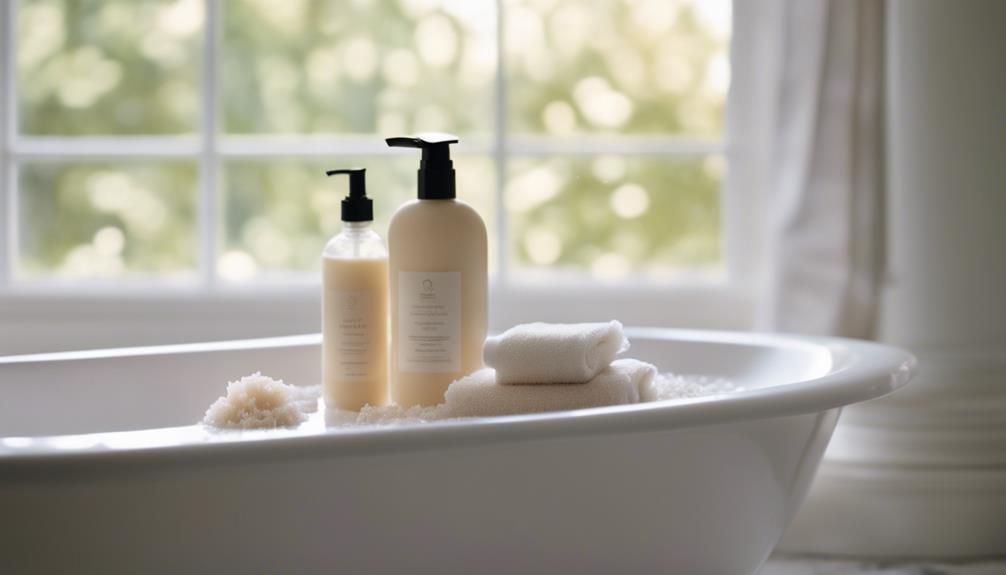
To keep your tan looking flawless, regular exfoliation plays a key role in guaranteeing a smooth, even surface for application. Exfoliation removes dead skin cells, which promotes a better foundation for your self-tanner. This not only enhances the overall appearance of your tan but also helps prevent patchiness by keeping your skin smooth and free of flaky areas.
For the best results, aim to exfoliate 24 hours before applying your self-tanner. This allows your skin to settle and creates an ideal canvas for a natural-looking tan. Using a gentle body scrub or an exfoliating mitt can effectively target dry patches, particularly on elbows and knees, which tend to absorb more product.
Incorporating weekly exfoliation into your routine is essential for maintaining radiant skin and prolonging the life of your tan. By regularly removing dull skin, you can guarantee your tan remains vibrant and long-lasting.
Make exfoliation a priority, and you'll enjoy a beautiful, even tan that lasts longer and looks fresh. Remember, the key to a great tan starts with a well-prepped, smooth surface!
Daily Moisturizing Routine
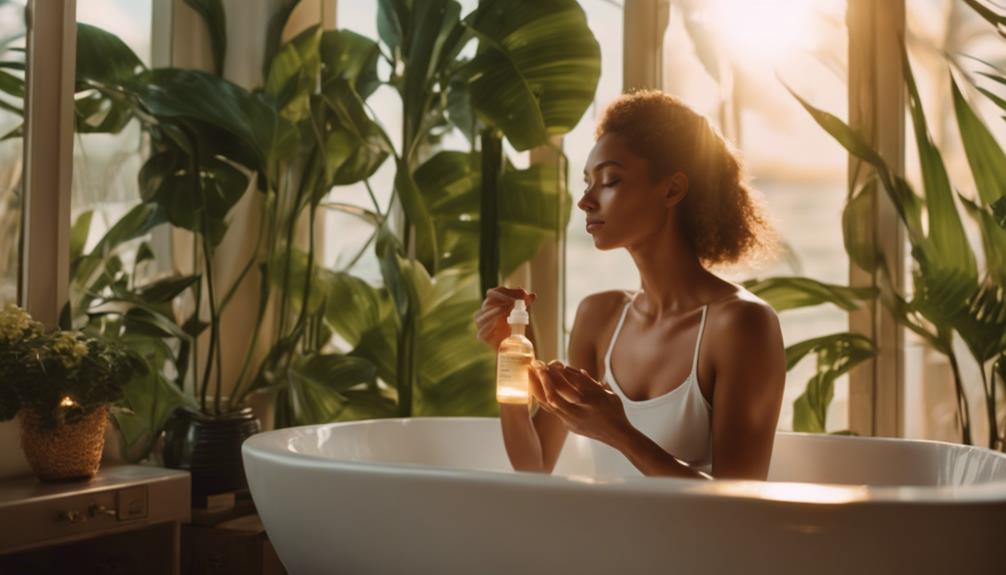
To keep your tan looking fresh and vibrant, hydration is key.
You'll want to choose the right moisturizer that suits your skin type and apply it at the right times for maximum effect.
Importance of Hydration
Maintaining a radiant tan hinges on daily moisturizing, as hydrated skin not only enhances tan retention but also prevents unsightly flakiness. To achieve this, invest in quality moisturizers free from harsh chemicals and alcohol. These products nourish your skin, supporting overall skin health and promoting tan longevity.
Make it a habit to apply lotion twice daily. This daily moisturizing routine guarantees your skin remains supple and enhances its elasticity. You might also consider using in-shower moisturizing products like shower oils to lock in moisture while you cleanse. These can provide ultra-hydration, extending the life of your tan.
In addition to topical moisturizers, don't underestimate the importance of drinking water. Aim for at least 8 glasses daily to stay adequately hydrated. Proper hydration not only improves your skin's appearance but also contributes considerably to maintaining your tan.
Choosing the Right Moisturizer
Choosing the right moisturizer is vital for keeping your tan vibrant and preventing uneven fading. When selecting moisturizers, avoid oil-based ingredients, as they can disrupt the self-tanning process. Daily application of hydrating lotions is important for maintaining skin moisture, enhancing tan retention, and boosting your tan's overall appearance.
Look for nourishing ingredients like hyaluronic acid, aloe vera, and vitamin E in your moisturizer. These components not only support skin health but also prolong your tan's longevity. Apply moisturizer twice daily, especially after showering, to lock in hydration and keep your skin smooth and vibrant.
Additionally, consider using illuminating body lotions or shimmering moisturizers. These products not only provide essential hydration but also enhance your tan's appearance, giving you that sun-kissed glow.
Remember, consistency is key; by maintaining a daily moisturizing routine, you'll guarantee your skin stays hydrated and your tan remains radiant longer.
Timing for Application
Applying moisturizer at the right times can considerably enhance your tan's longevity and keep your skin looking its best. To maintain an even tan, you should apply body lotion twice daily, focusing on areas prone to dryness. This daily routine helps keep your skin hydrated and enhances elasticity, which is essential for prolonging the life of your self tanning results.
Incorporate tan-friendly moisturizers that are free from harsh chemicals and oil-based ingredients, as these can disrupt your tan. Consider using moisturising shower oils right after bathing; they lock in hydration and set a solid foundation for your skincare.
Don't forget that consistent hydration goes beyond topical products. Drink plenty of water to support your skin's health from the inside out. By sticking to this routine, you'll not only keep your skin looking vibrant but also guarantee your tan lasts longer and fades evenly.
Following these expert tips will help you embrace your sun-kissed glow while maintaining your skin's health and appearance. So, remember to moisturize daily to keep your skin looking its best!
Extending Your Outdoor Tan

To keep your outdoor tan looking fresh and vibrant, regularly moisturize your skin with a nourishing self-tanner that boosts hydration and color. This step is essential for extending the life of your tan while keeping your skin healthy.
Incorporate a moisturizing shower into your routine, using cool water to prevent dehydration that can lead to peeling and a dull appearance.
Exfoliate your skin gently once a week to maintain an even base for your tan. This helps remove dead skin cells, allowing your self-tanner to apply smoothly and evenly.
Additionally, drink at least 8 glasses of water daily to support hydration from within, making your natural glow last longer.
To enhance your tan's visual appeal, consider using illuminating body lotions or shimmering moisturizers. These products not only highlight your tan but also provide extra hydration, ensuring your skin remains soft and supple.
By following these tips, you'll keep your outdoor tan looking radiant and fresh, without needing excessive sun exposure.
Products to Avoid

To keep your tan looking its best, you need to avoid certain products that can strip away color and cause unevenness.
Harsh exfoliating products and oil-based moisturizers should be on your radar, as they can compromise your tan's longevity.
Harsh Exfoliating Products
Harsh exfoliating products, like aggressive body scrubs and peels, can strip away your tan faster than you think. To maintain your tan and keep that sun-kissed glow, you need to carefully select your skincare products. Avoid anything with abrasive ingredients or strong exfoliating properties, such as salicylic acid, which can cause your self-tan to fade prematurely.
It's essential to review your skincare routine regularly. Eliminate any products that contain harsh exfoliants, as they're not just harmful to your tan, but can also compromise your skin health.
Instead, focus on gentle cleansers and moisturizers that respect various skin types. These options help you maintain your tan without the risk of burning or irritation.
Oil-Based Moisturizers
While you're avoiding harsh exfoliating products, it's equally important to steer clear of oil-based moisturizers that can sabotage your tan. These products can break down tanning agents, leading to uneven fading and patchiness. Ingredients like mineral oil and petroleum jelly form a barrier that prevents proper absorption of self-tanning solutions. Consequently, using oil-based moisturizers post-tan may cause your skin to shed the color faster, reducing its longevity.
Instead, opt for water-based or gel-based moisturizers designed to be tan-friendly. These alternatives hydrate your skin while maintaining a consistent tan. Regularly check your products for oil-based ingredients to verify you're extending the life of your tan.
| Oil-Based Products | Water-Based Alternatives |
|---|---|
| Mineral Oil | Aloe Vera Gel |
| Petroleum Jelly | Lightweight Lotion |
| Coconut Oil | Hydrating Gel |
| Creamy Formulations | Moisturising Shower Gel |
Hydration and Skin Health
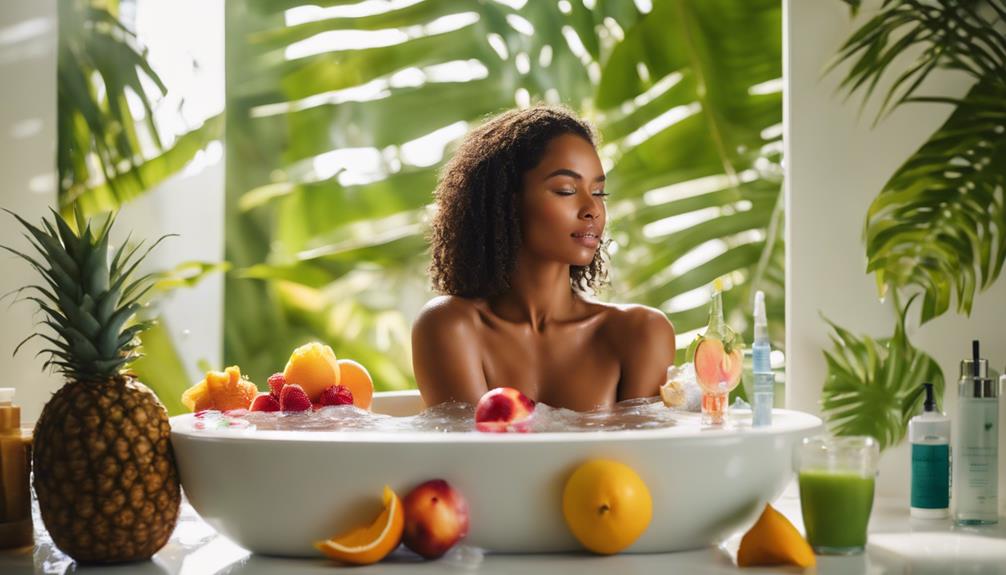
Staying hydrated is key to keeping your tan vibrant and your skin healthy. Proper hydration not only enhances your tan but also prevents dryness and flakiness.
Here are some expert tips to guarantee your skin stays moisturized:
- Drink Water: Aim for at least 8 glasses of water daily. Adequate hydration supports your skin's elasticity and overall health.
- Daily Moisturizing: Use non-oil-based moisturizers to lock in moisture. This helps prolong your tan by reducing patchiness.
- Gentle Body Washes: Avoid hot showers and harsh soaps. Opt for lukewarm water and moisturizing body washes to maintain your skin's moisture balance.
- Hydrating Foods: Incorporate hydrating foods like cucumbers and watermelon into your diet. These can improve your skin condition and help retain your tan.
Additionally, consider using body butter or oils infused with hyaluronic acid. Regular application can considerably extend the vibrancy of your tan while promoting smoother skin.
Using Illuminating Moisturizers
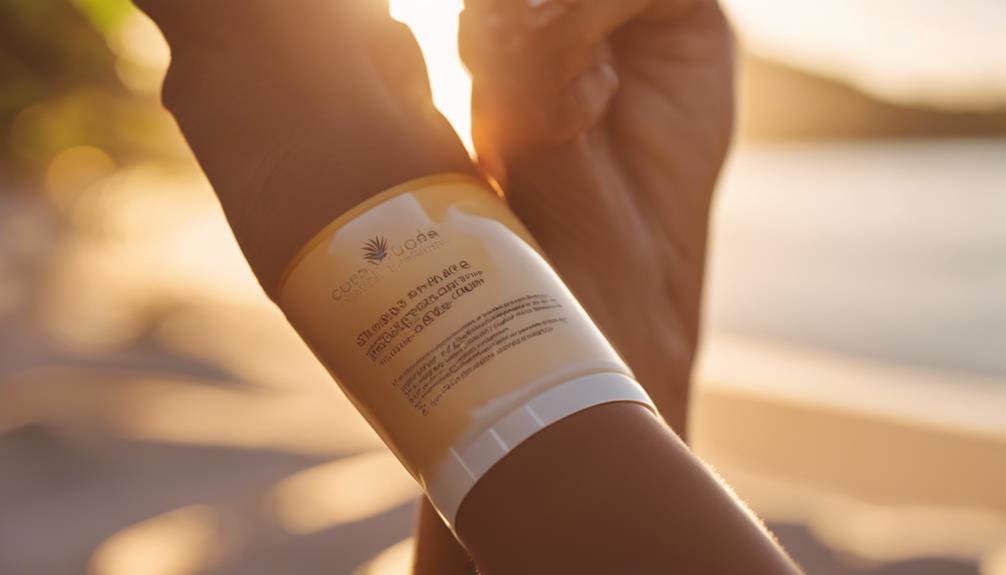
Using illuminating moisturizers can greatly enhance your tan by adding a radiant glow and highlighting your bronzed skin tones. These products are designed with light-reflecting particles that create a luminous effect, making your skin look healthier and more vibrant. By incorporating illuminating moisturizers into your routine, you can markedly enhance the appearance of your tan.
Regular application of these hydrating lotions helps to extend the life of your tan by keeping your skin well-moisturized and reducing flaking. Look for non-greasy, fast-absorbing formulas to guarantee a seamless finish that won't disrupt your self-tanner. This way, you can maintain that beautiful, bronzed look without any greasy residue.
To get the best results, apply the illuminating moisturizer daily, focusing on areas where the sun naturally hits, like your arms and shoulders. This won't only keep your tan looking fresh but also provide that extra shimmer you desire.
Daily Sunscreen Application

Applying daily sunscreen with at least SPF 30 is essential for protecting your skin from UV damage and helping to maintain your tan. Without proper protection, your tan can fade quickly, and you risk sunburn and peeling.
Here are some tips for effective sunscreen application:
- Choose a broad-spectrum sunscreen with SPF 30 or higher to protect against UV damage.
- Apply sunscreen evenly over all exposed areas of your skin before dressing. Don't forget spots like ears, feet, and the back of your neck.
- Reapply sunscreen every two hours, or more frequently if you're swimming or sweating, to maintain protection throughout the day.
- Opt for a sunscreen with hydrating ingredients to help maintain skin moisture and enhance the vibrancy of your tan.
Clothing Choices for Tan Enhancement

The right clothing choices can greatly enhance the appearance of your tan, making your skin glow even more vibrantly. To showcase your sun-kissed body, consider fabrics and colors that complement your golden tones. Dark clothing can accentuate your tan, making it appear richer and more vibrant, while pastel shades can create a fresh look that harmonizes with warm hues.
Here's a quick guide to help you choose the best options:
| Clothing Type | Enhancement Effect |
|---|---|
| Dark Clothing | Accentuates golden tones, rich look |
| Pastel Colors | Complements warm hues, fresh appearance |
| White Fabrics | Creates striking contrast, skin pops |
| Sheen Fabrics | Reflects light, highlights bronzed skin |
| Statement Jewelry | Bold colors boost visual appeal |
Incorporating natural oils into your skincare routine can also enhance the overall glow of your tan. Don't forget to accessorize with statement jewelry in bright colors to elevate your style and further enhance your vibrant look. Choose wisely, and let your tan shine!
Frequently Asked Questions
How Do I Keep My Tan Lasting?
To keep your tan lasting, regularly moisturize your skin, exfoliate gently weekly, and apply gradual tanning products. Stay hydrated and always use sunscreen to protect against fading and maintain your skin's vibrancy.
How Do You Maintain Fake Tan?
To maintain your fake tan, exfoliate gently before reapplication, moisturize daily, and use a gradual tanner every few days. Drink water and apply sunscreen regularly to protect your tan and keep your skin healthy.
What Is the Best Way to Maintain a Spray Tan?
Did you know nearly 30% of people lose their spray tan within a week? To maintain yours, exfoliate before application, wear loose clothing afterward, hydrate your skin, and avoid sweating for the first 24 hours.
How Can I Make My Instant Tan Last Longer?
To make your instant tan last longer, moisturize daily, avoid oil-based products, and exfoliate before reapplying. Drink plenty of water and use SPF 30 sunscreen to protect your tan from fading and damage.
Can Oily Skin Affect the Maintenance of a Tan?
Having oily skin can affect the maintenance of a tan, but with the right expert tips for oily skin, you can still enjoy a healthy glow. Use oil-free sunscreen to prevent sunburn and excess oil production. Also, exfoliate regularly to remove dead skin cells and help your tan last longer.
Conclusion
To keep your tan glowing like the summer sun, remember to nurture your skin daily.
Embrace moisturizing and exfoliation as your golden allies, while hydration fuels that radiant hue.
Picture your skin as a canvas; with the right products and habits, it'll shine brightly.
So, slather on that sunscreen and choose your outfits wisely to enhance your sun-kissed glow.
With these expert tips, your tan can last longer than a summer breeze!
Tanned Skin
Unlocking the Secret to a Deeper Tan
Harness the power of tanning strategies to achieve a deeper glow—discover the essential tips that will transform your sunbathing experience!

Revealing the secret to a deeper tan is all about strategy, not just sunbathing! First, know your skin type—fair skin needs more care, while darker skin can handle a bit more UV. Start with 3-5 initial tanning sessions to establish a base, spacing them out to avoid burns. Use tanning lotions with L-tyrosine to boost melanin and keep your skin hydrated. Don't forget those stylish goggles; your eyes need love too! Finally, if you hit a tanning plateau, switch it up. With the right techniques, you're on the path to that golden glow. Ready for more tips?
Key Takeaways
- Identify your skin type to tailor your tanning sessions and avoid burns, ensuring optimal results for a deeper tan.
- Use tanning lotions with L-tyrosine to boost melanin production and enhance your tanning efficiency.
- Track your sessions and maintain a routine of 3-5 initial visits, followed by touch-ups every few weeks for consistency.
- Stay hydrated and moisturize post-session to prevent dry skin, which can hinder tanning results by reflecting light.
Tanning Sessions and Frequency
When you start your tanning journey, aim for 3-5 initial sessions to build a solid base tan. Think of this as laying the foundation for your golden glow!
If you've got fair skin, you might need a few extra sessions, but don't worry. After those first few visits, plan for 3-4 weekly touch-ups to keep that sun-kissed look alive.
You'll typically see some color peeking through after just a few sessions, but patience is key. Remember to let your skin breathe; wait at least 48 hours between sessions to avoid overexposure.
Consistency is important, so keep track of your visits, and soon you'll be strutting around with the tan of your dreams!
Understanding Skin Types
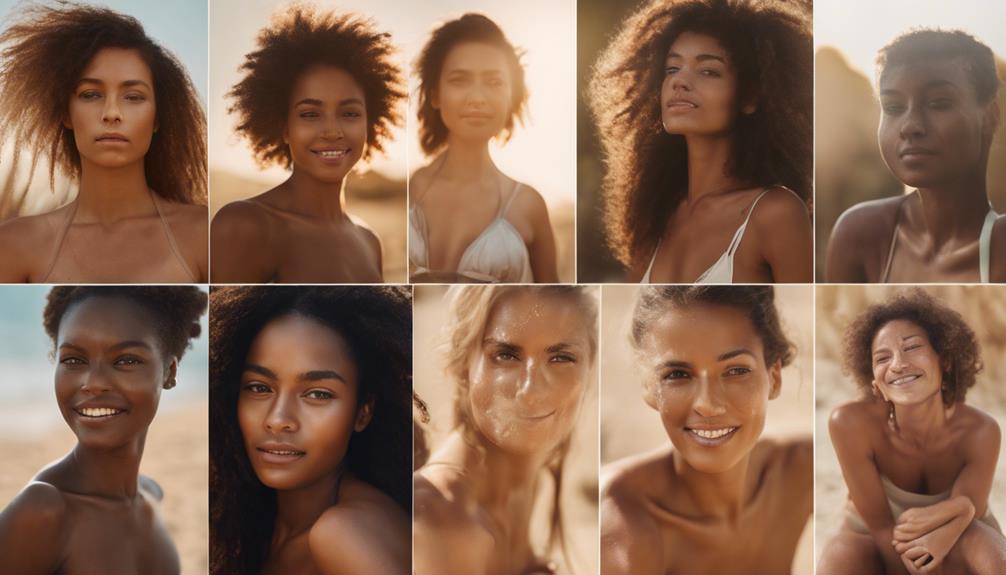
Identifying your skin type is essential for effective tanning and preventing burns.
You've got to know if you're fair, medium, or dark because that'll guide your tanning journey. Fair skin might burn faster, while darker skin types can usually handle more UV rays without turning into a lobster.
Understanding your melanin levels acts like a built-in sunblock, helping you tan safely. You'll want to adjust your tanning sessions based on your skin type, so you don't end up looking like a tomato!
Always wear protective eyewear, too, because squinting isn't a good look. By being smart about your skin type, you can achieve that golden glow while keeping your skin happy and healthy.
Now, let's get glowing!
Tanning Lotions and Accelerators
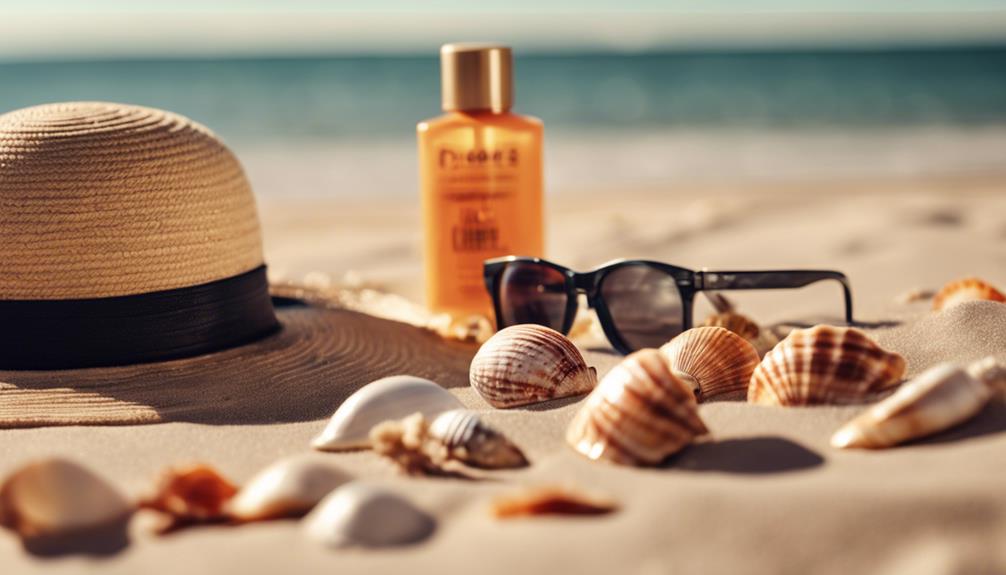
Tanning lotions and accelerators play an essential role in enhancing your glow while protecting your skin during tanning sessions.
When you pick the right lotion, you're not just slathering on some cream; you're giving your skin a boost! Look for products with moisturizers and SPF, as they hydrate and guard against sun damage.
Applying lotion evenly is key for that flawless tan, so don't skip any spots—your skin will thank you later! Plus, those lotions with L-tyrosine can really ramp up melanin production, helping you achieve that golden hue faster.
After your tanning session, remember to moisturize again to keep your tan looking fresh and vibrant. It's the secret sauce to a long-lasting, beautiful tan!
Recognizing Tanning Plateaus

Recognizing tanning plateaus is key to understanding when your skin has reached its maximum melanin production and needs adjustments to continue deepening your tan. When you hit this plateau, don't panic!
Here are three fun strategies to keep your glow going:
- Switch it Up: Try a different tanning bed. Different UV rays can kickstart your melanin production again.
- Take a Break: Give your skin a little rest. A short break can help avoid overexposure and keep your skin healthy.
- Stay Hydrated: Drink plenty of water. Dry skin reflects light instead of soaking it up, so keep that skin moist!
Keep these tips in mind, and you'll be back on the path to that deep, golden tan in no time!
Safety Practices for Tanning

Prioritizing safety is essential to enjoying a healthy tanning experience without risking skin damage.
First, know your skin type—this helps you avoid painful burns. Make sure you wear protective eyewear; your eyes deserve better than UV rays!
When you start tanning, begin with shorter sessions and gradually increase the time as your skin adjusts. Remember, patience is key; no one wants to look like a lobster!
Always use quality tanning lotions with SPF; they hydrate your skin while helping you achieve that golden glow.
And don't forget to space out your sessions, allowing at least 48 hours between them.
Common Tanning Myths
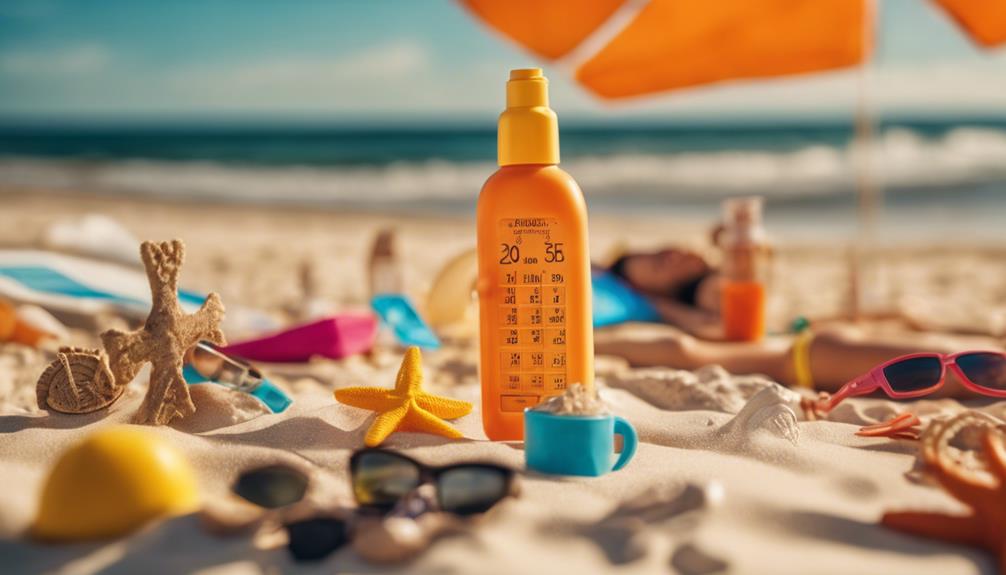
Many people fall for common tanning myths that can lead to unsafe practices and unrealistic expectations. Let's bust a few of these myths together!
- Base Tan Equals Burn Protection: Some think getting a base tan prevents burns. Nope! It only offers minimal protection, like SPF 3.
- Tanning Beds Are Safer Than the Sun: Many believe tanning beds are a risk-free way to tan. Wrong again! They expose you to harmful UV rays.
- Dark Skin Doesn't Need Protection: Just because you have a deeper skin tone doesn't mean you're immune to sun damage. Everyone needs protection!
Trending Tanning Products
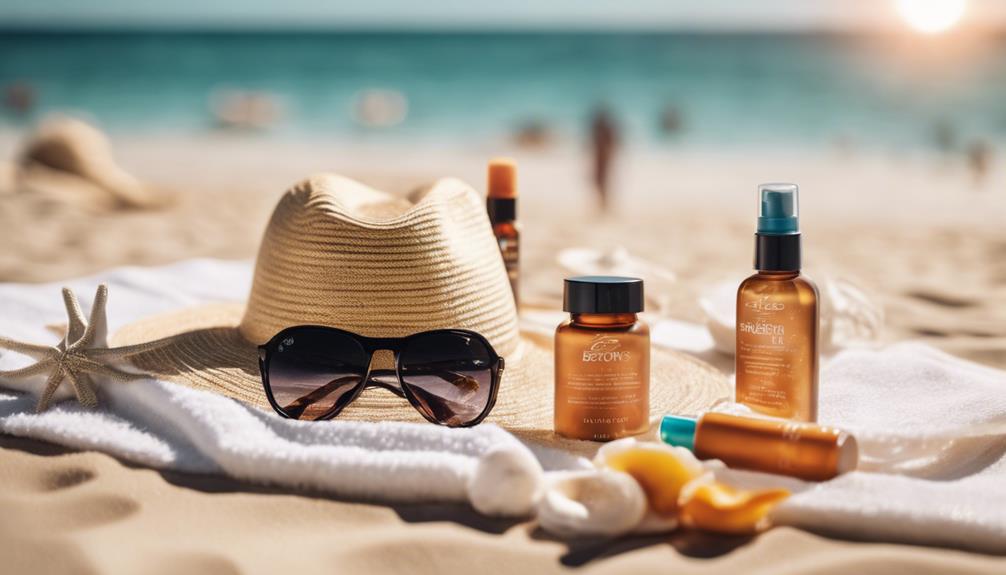
When it comes to achieving the perfect tan, staying updated on trending tanning products can make a significant difference in your results. You'll want to check out the latest tanning lotions that not only boost melanin production but also keep your skin hydrated.
Look for products with L-tyrosine, a fancy ingredient that helps you tan faster. And don't forget the tan accelerators—they're like your new best friends for a golden glow!
To protect your eyes and skin, grab some stylish tanning goggles and maybe a cute face cover for those extra sunbed sessions.
With the right products, you'll be strutting your stuff with that deep, sun-kissed tan in no time, and your friends might just be a little jealous!
Frequently Asked Questions
Can I Tan if I Have a Sunburn?
You shouldn't tan with a sunburn. Your skin needs time to heal, and tanning can worsen the burn, leading to more damage. Focus on soothing your skin before resuming any tanning sessions safely.
Does Diet Influence My Tanning Results?
Yes, your diet does influence tanning results. Consuming foods rich in antioxidants, vitamins A, C, and E can enhance skin health and melanin production, helping you achieve a more radiant and longer-lasting tan. Stay nourished!
How Long Does a Tan Typically Last?
A tan typically lasts about 7 to 10 days, depending on your skin type and care. To extend it, moisturize regularly and avoid exfoliating too much. Staying hydrated also helps maintain that golden glow.
Can I Use Self-Tanner After Tanning Sessions?
Think of your skin as a canvas. Yes, you can use self-tanner after tanning sessions, but wait until your tan settles. This way, you'll achieve a richer, more even glow without streaks or patches.
Will Tanning Affect My Skincare Products' Effectiveness?
Tanning can temporarily reduce your skincare products' effectiveness, as UV exposure may cause skin barrier changes. To maintain benefits, apply your products after tanning sessions and allow them time to absorb before further exposure.
Conclusion
So, there you have it!
With a little patience and the right products, you can achieve that dazzling, deep tan you've always wanted.
Remember, it's all about scheduling your sessions, selecting suitable lotions, and staying safe under the sun.
Don't fall for common tanning myths—knowledge is power!
So, embrace your unique skin type, and let your tanning journey be a fun and fabulous one.
Get ready to glow, and show off that stunning sun-kissed skin!
Tanned Skin
Revitalize Your Skin After Tanning
How to rejuvenate your skin after tanning and maintain that sun-kissed glow—discover essential tips that will leave you wanting more!
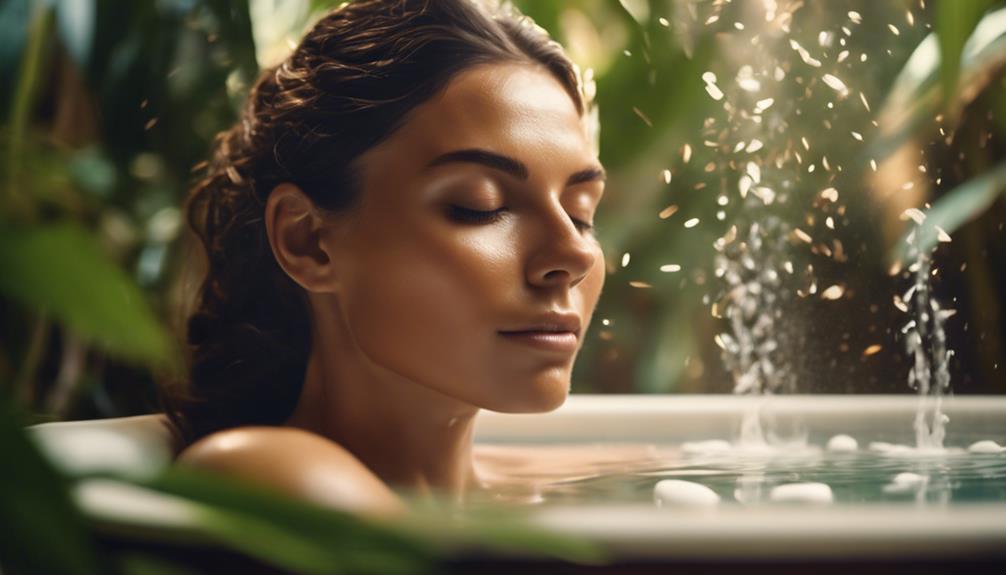
Revitalizing your skin after tanning is super important for keeping it looking fresh and fabulous! First, hop in the shower and slather on a thick moisturizer to lock in moisture. Don't forget sunscreen with SPF 30 or higher to protect against those sneaky UV rays—reapply every two hours! Hydrate like a champ by guzzling water and munch on fruits and nuts to nourish your skin from the inside out. Oh, and keep an eye on skin reactions; if things get itchy, a good aloe vera gel can work wonders. Stick around, and you'll find even more helpful tips!
Key Takeaways
- Apply a rich post-tan moisturizer immediately after showering to replenish and lock in skin moisture.
- Use sunscreen with SPF 30 or higher, reapplying every two hours to protect your skin from UV damage.
- Incorporate antioxidant-rich products and snacks like berries and nuts to nourish and aid skin recovery after tanning.
- Stay hydrated by drinking plenty of water daily to maintain skin plumpness and overall health.
Post-Tanning Skin Care Essentials
After tanning, your skin craves hydration and nourishment to maintain that sun-kissed glow.
First things first, slather on a post-tan moisturizer right after showering—it helps lock in moisture and keeps your skin feeling soft.
Don't forget your sunscreen! Grab one with SPF 30 or higher, even if you're just stepping outside for a quick errand. Reapply it every two hours, and keep sipping that water to hydrate from the inside out.
To avoid looking like a patchy potato, exfoliate gently 1-2 times a week.
And hey, munching on fruits and omega-3s can work wonders for your skin too!
It's all about taking care of yourself so that radiant tan lasts longer and looks fabulous!
Effective Hydration Techniques

To keep your skin glowing and healthy post-tanning, prioritize deep hydration by using products rich in hyaluronic acid and aloe vera.
These ingredients pull moisture into your skin, making it feel revitalized and rejuvenated. Plus, who doesn't love that soft, bouncy feeling?
Here are some effective hydration techniques you can try:
- Apply a thick layer of moisturizer right after showering.
- Use a hydrating serum before your moisturizer for an extra boost.
- Keep a bottle of aloe vera gel in your fridge for an invigorating cool-down.
- Don't forget to drink plenty of water throughout the day.
With these tips, you'll keep your skin happy and hydrated!
Importance of Sun Protection
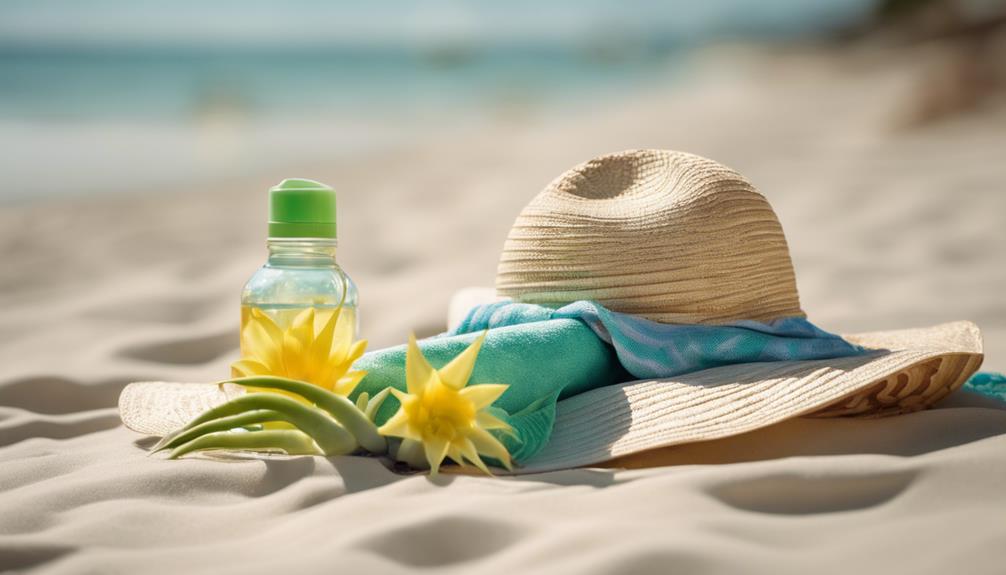
Sun protection is essential for keeping your skin healthy and preserving that beautiful tan you've worked hard for. You wouldn't want your glow to fade away, right? Applying sunscreen daily, even when you're indoors or it's cloudy, can make a huge difference. Check out the quick tips below to stay sun-safe!
| Tip | Description |
|---|---|
| Use SPF 30 or higher | Protects your skin from harmful rays. |
| Reapply every 2 hours | Keep that protection going all day! |
| Wear protective eyewear | Shields your eyes from UV damage. |
| Stay hydrated | Drink plenty of water for skin health! |
Nourishing Your Skin
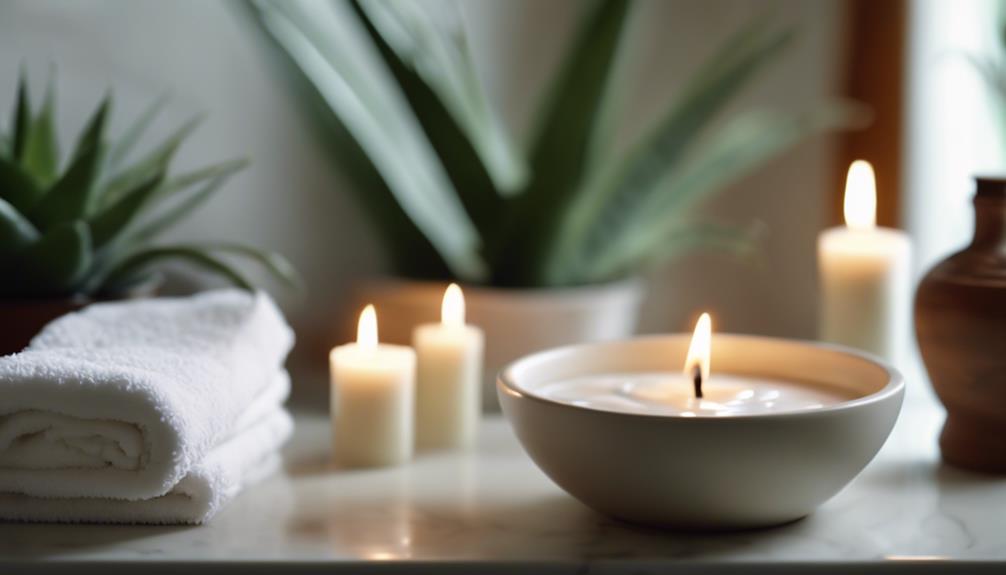
Nourish your skin with antioxidant-rich products that support recovery and maintain a radiant glow after tanning. Your skin's been through a lot, and it deserves some TLC! Here's how to give it the love it needs:
Look for lotions packed with vitamins C and E to repair damage.
Consider aloe vera gels to cool and soothe any irritation.
Snack on berries and nuts—your skin will thank you from the inside out!
Use a gentle exfoliant once or twice a week to keep your skin smooth.
Don't forget to hydrate! Water helps keep your skin plump and happy.
Treat your skin like the superstar it is, and you'll rock that tan with confidence!
Monitoring Skin Reactions
Keeping an eye on your skin's reactions after tanning is important for ensuring it stays healthy and radiant. You might notice some redness or itching, which can happen after a tanning session. If that occurs, don't panic! Just grab your favorite moisturizer and apply it right away to soothe your skin.
But if those pesky reactions stick around, it might be time to consult a dermatologist—better safe than sorry! Remember, your skin's health is key to enjoying that sun-kissed glow. So, stay aware and give your skin the love it deserves.
After all, nobody wants to trade a radiant tan for a red, irritated mess. Keep monitoring, and your skin will thank you with a beautiful, lasting glow!
Tanning Bed Alternatives
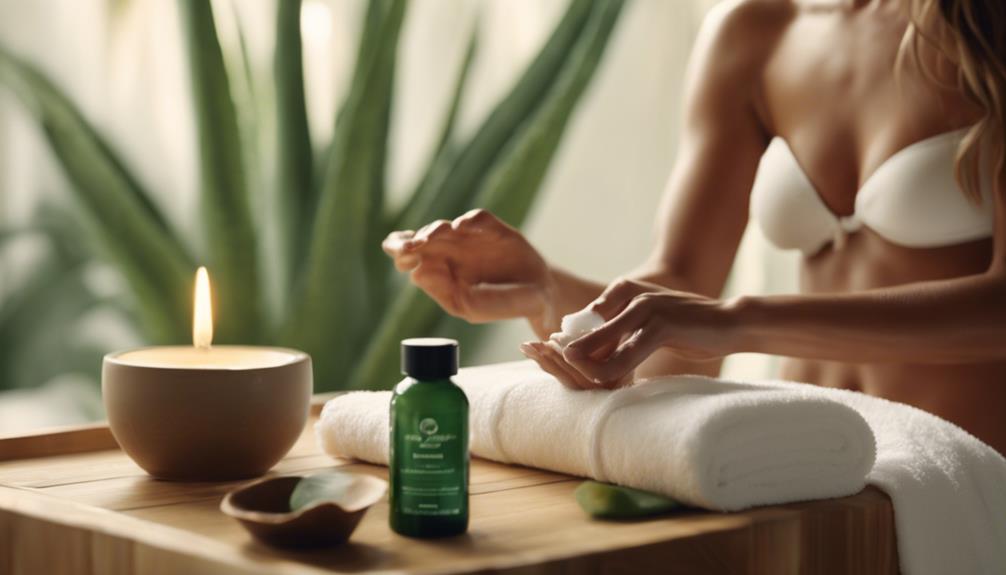
Many people often seek safer alternatives to tanning beds for achieving that coveted sun-kissed glow without the associated risks. Luckily, there are several options that can give you that bronzed look without baking under harmful UV rays.
Here are some popular tanning bed alternatives to contemplate:
- Self-tanning lotions: Apply these for a gradual tan that develops over time.
- Spray tans: Quick and easy, they provide an instant glow with no waiting!
- Tanning oils: Some contain natural bronzers for a subtle glow.
- Bronzing powders: Perfect for a temporary touch-up before an event.
With these alternatives, you can enjoy a beautiful tan while keeping your skin healthy. Who knew looking good could be so easy?
Community Insights on Tanning

Exploring tanning bed alternatives opens up discussions within the community about safer tanning practices and personal experiences that can guide others in their quest for a golden glow.
You might find that many folks share tips on achieving that sun-kissed look without the risks of tanning beds. They often talk about their favorite self-tanners or sunless options, and how much they love the glow without the UV exposure.
Plus, you'll hear stories about mishaps and successes that make you chuckle, like the infamous orange streaks! Engaging in these conversations not only helps you learn but also connects you with others who share your tanning journey.
Frequently Asked Questions
How Long Does a Tan Typically Last After Tanning?
A tan typically lasts about 7 to 10 days, depending on your skin type and aftercare. To extend it, hydrate your skin regularly and avoid harsh exfoliation, which can accelerate fading.
Can I Use Regular Lotion Instead of Post-Tan Moisturizer?
You can use regular lotion, but it's best to opt for a post-tan moisturizer. These products are designed to hydrate and soothe your skin effectively, ensuring better results and longer-lasting color.
What Are the Signs of Over-Tanning to Watch For?
When over-tanning, you'll notice signs like redness, peeling, or excessive dryness. Your skin might feel itchy or sensitive. If these symptoms appear, it's essential to moisturize and take a break from tanning to allow recovery.
Are There Any Foods That Enhance Tanning Results?
Yes, certain foods can enhance tanning results. Incorporate carrots, sweet potatoes, and tomatoes into your diet; their high beta-carotene content boosts your skin's natural glow. Hydration and omega-3s also support a radiant complexion.
How Often Should I Tan for Optimal Results?
Imagine basking in the sun, your skin glowing golden. For ideal results, tan 1-2 times a week, allowing your skin to recover in between sessions. Listen to your body's signals and adjust as needed.
Conclusion
So, you've tanned and now it's time to pamper your skin!
Remember, keeping that gorgeous glow isn't just a one-and-done deal; it needs a little TLC. Hydrate, protect, and nourish to keep your skin looking its best.
But wait, what happens if you don't? You might end up with a patchy tan or, yikes, sun damage!
Don't let that happen to you. Stick to these tips, and you'll be flaunting that bronzed beauty with confidence!
Tanned Skin
Tanning Bed Overuse: Spot the Warning Signs
Get informed about the warning signs of tanning bed overuse and learn how to protect your skin before it's too late!

If you're using tanning beds too much, watch out for some telltale signs! If your skin feels extra sensitive, red, or itchy, that's your body waving a little flag! Also, dryness and peeling aren't exactly signs of a beach day; they mean it's time to take a break. Keep an eye on any moles or spots—changes in color or size are worth mentioning to a doctor. And don't forget your eyes; gritty or red eyes after tanning could mean trouble. So, be smart about your glow, and stick around to find out how to keep your skin safe!
Key Takeaways
- Look for unusual sensitivity, redness, or itchiness as early warning signs of skin damage from tanning bed overuse.
- Monitor for dryness or peeling skin, indicating potential overexposure to UV rays.
- Be aware of new freckles or changes in existing moles, which could signal skin cancer risk.
- Protect your eyes with goggles to prevent irritation and long-term damage from UV exposure during tanning sessions.
Signs of Skin Damage
When you notice unusual sensitivity, redness, or itchiness on your skin, it's a clear sign that you may be experiencing damage from tanning bed overuse. Your skin's like a delicate flower, and too much sun can make it wilt!
If you see dryness or peeling, that's another red flag waving at you. Itchy rashes can pop up after those tanning sessions, signaling that you've crossed the line into excessive UV exposure.
Don't ignore these signs; they might seem minor now, but they could lead to serious issues later. Persistent redness and itchiness aren't just annoying; they mean your skin's in distress. So, listen to your skin—it's trying to tell you something important before things get really serious!
Effects on Skin Aging
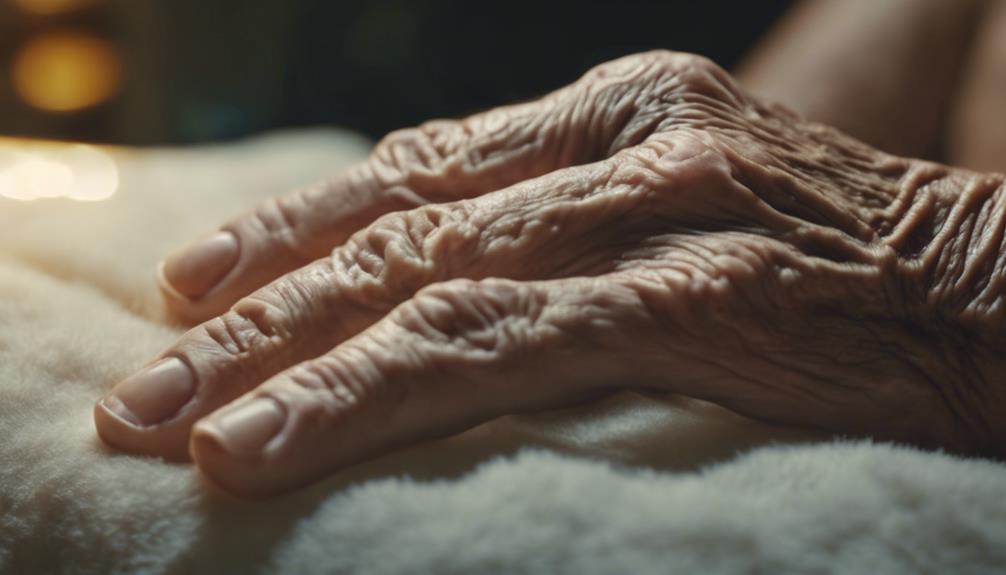
Ignoring the signs of skin damage can lead to accelerated aging, as frequent tanning beds break down collagen and elastin, resulting in premature wrinkles and sagging.
You might think that a bronzed glow makes you look younger, but the truth is, it can actually age you faster! Each time you expose your skin to those harsh UV rays, you're inviting fine lines, uneven skin tone, and a leathery texture to the party. Yikes!
Your skin deserves better than that. Instead of chasing that golden hue, consider embracing your natural beauty or trying safer alternatives like self-tanners.
Monitoring Moles and Spots
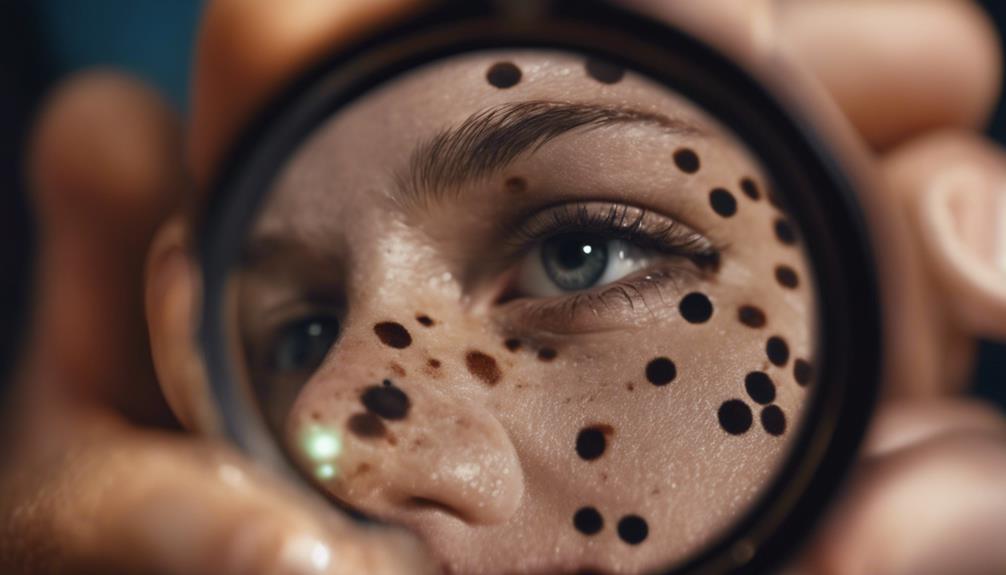
Regularly checking your moles and skin spots is essential for spotting potential signs of skin cancer early on. Think of it as a little skin detective work!
Look for changes in color, size, or shape. If you notice a mole that's growing faster than your favorite plant, it's time to get it checked out. New freckles popping up after those tanning sessions? Keep an eye on them. You want your skin to be happy, not stressed!
Remember, moles with jagged edges or weird colors are like warning lights on your car—don't ignore them! By staying vigilant, you can catch issues before they escalate.
After all, your skin deserves all the TLC it can get!
Eye Irritation Risks

If you experience gritty or red eyes after a tanning session, it could signal potential UV overexposure that warrants immediate attention. You might think, “It's just a little irritation,” but ignoring those warning signs can lead to serious eye problems.
Protecting your peepers is super important! Always wear protective goggles while tanning, or you risk facing issues like photokeratitis, which feels like having sand in your eyes. Ouch!
Plus, over time, too much UV exposure can increase your chances of developing cataracts and even macular degeneration. So, the next time you hit that tanning bed, remember to shield your eyes, because you want your vision to last as long as your glow!
Keep those eyes happy and healthy!
Health Risks and Prevention
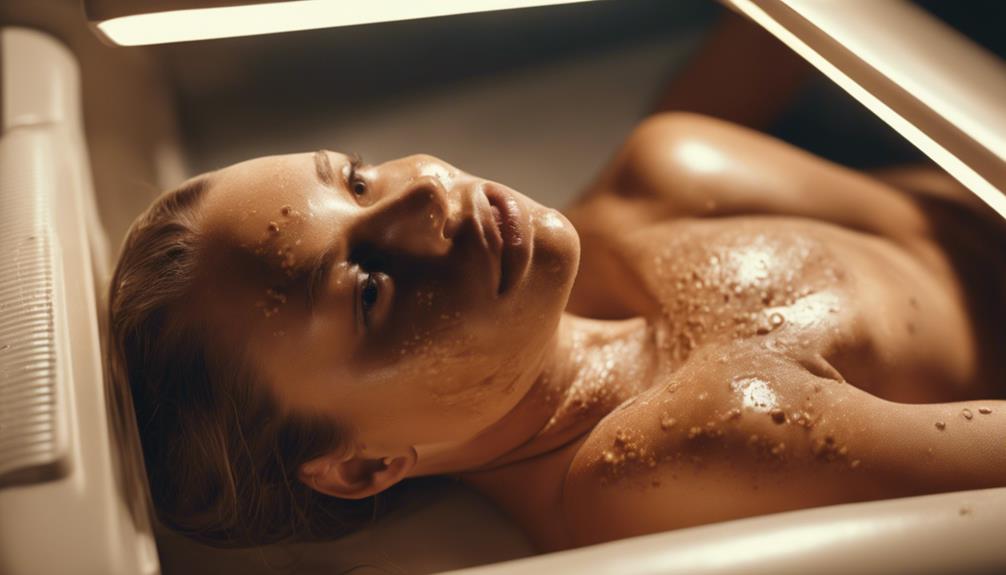
Excessive tanning bed use greatly increases your risk of developing skin cancers, including melanoma, especially if you start before age 35. Yikes! You definitely don't want that.
Here are some quick tips to help you stay safe:
- Use tanning goggles to protect your eyes from harmful rays.
- Limit tanning sessions to reduce overall UV exposure.
Frequently Asked Questions
How Often Should I Use Tanning Beds Safely?
You should limit tanning bed use to once every two weeks for safe exposure. Always monitor your skin's reaction, and consider alternatives like self-tanners to achieve a bronzed look without the risks of UV damage.
What Are the Benefits of Natural Sun Exposure Vs. Tanning Beds?
Natural sun exposure provides vitamin D, boosts mood, and promotes healthier skin without the risks associated with tanning beds. You'll enjoy a more balanced and safer approach to achieving that sun-kissed glow while protecting your skin.
Can Tanning Beds Cause Hair Damage or Changes?
Using tanning beds is like playing with fire; it can scorch your hair. UV exposure might dry it out, leading to brittleness and color changes. Protect your locks by limiting tanning sessions and using proper hair care.
Are There Specific Skin Types More at Risk From Tanning?
Yes, certain skin types are more at risk from tanning. Fair-skinned individuals, those with freckles, or a history of sunburns face higher chances of damage. Always consider your skin type before exposing yourself to UV rays.
What Are the Best Alternatives to Achieve a Tan Safely?
Getting a tan naturally is like basking in the sun's warm embrace. Try self-tanners, bronzing lotions, or tinted moisturizers for a sun-kissed glow without UV risks. You'll achieve a beautiful tan safely and effectively!
Conclusion
So, before you dive headfirst into that tanning bed like it's a giant pool of liquid sunshine, remember to listen to your skin!
If it starts throwing tantrums with redness or itchiness, it's waving a big red flag. Protect yourself from those sneaky skin villains and keep an eye on any weird moles.
Opt for safer alternatives, like self-tanners or bronzers, and keep your skin happy, healthy, and glowing without the risks!
Your skin will thank you!
-

 Vetted4 months ago
Vetted4 months ago15 Best Tanning Accelerators for a Sun-Kissed Glow This Summer
-
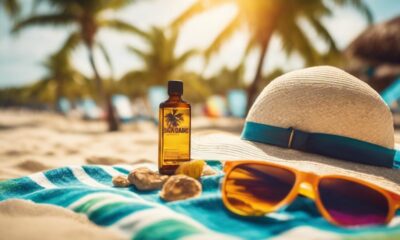
 Vetted4 months ago
Vetted4 months ago15 Best Tanning Oils for a Perfect Sun-Kissed Glow in 2024
-

 Vetted4 months ago
Vetted4 months ago15 Best Sun Tanning Products for a Gorgeous Glow This Summer
-

 Sun Protection4 months ago
Sun Protection4 months agoHow to Protect Your Skin Without Staying Indoors All Day
-

 Sun Protection4 months ago
Sun Protection4 months ago10 Sun Protection Myths Debunked!
-
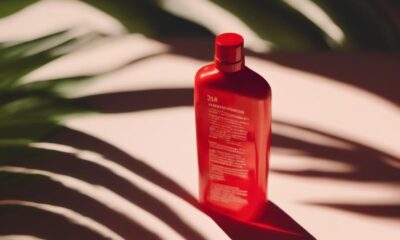
 Sun Protection4 months ago
Sun Protection4 months agoWhat Dermatologists Wish You Knew About Sunburns
-

 Sun Protection4 months ago
Sun Protection4 months agoThe Best Sun Protection Routine for Your Skin Type
-
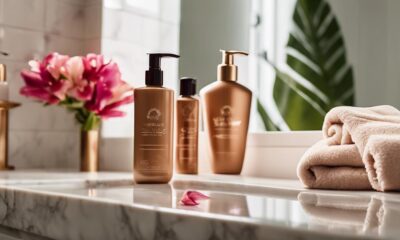
 Vetted4 months ago
Vetted4 months ago15 Best Fake Tanning Lotions for a Sun-Kissed Glow All Year Round









